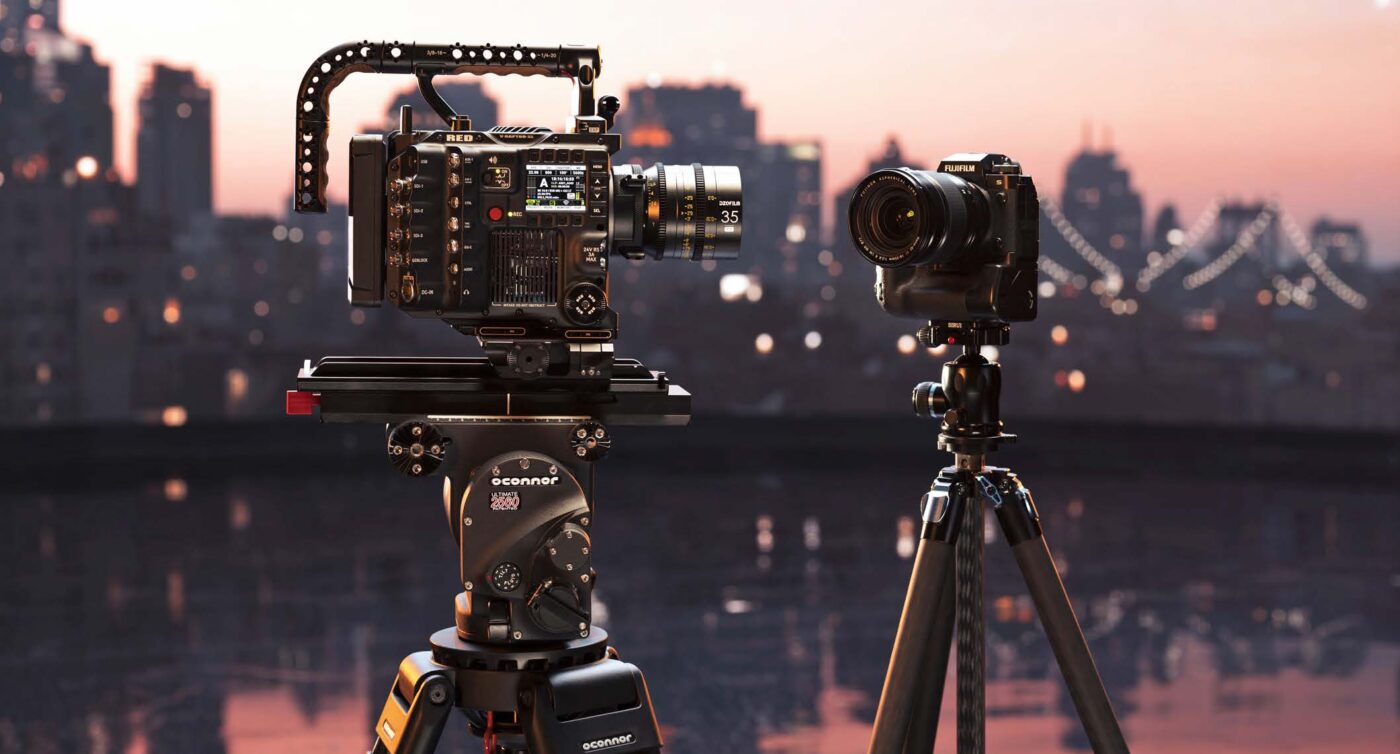
Michael Cioni was like an orchestra conductor in a candy store at Cine Gear LA this past June. The Adobe Frame.io booth was festooned with partners whose cameras, audio recorders and post production apps played nicely with Frame.io’s Camera to Cloud and Adobe’s Creative Cloud services.
A few months ago, Michael was on the phone with more exciting updates. Our discussion was long and interesting. Ask him one question and that will elicit a wordflow —WORDFLOW! — that requires no additional prompting.
Michael began, “I joined Frame.io a little over three years ago, and you were one of the first people I talked to. I still remember where I was standing. You were under NDA. And what wasn’t clear, what wasn’t known at the time, was that when we talked back in the late summer of 2019, I had already met with Jarred Land and David Fincher, talking about the C2C concept. It was just a whiteboard, ‘What if? Wouldn’t it be great?’ kind of a thing. RED had not yet built RAPTOR or KOMODO, but they had started moving towards their DSMC3 line, and they wanted to ensure that the next set of products unlocked certain attributes that weren’t previously possible anywhere.
“What’s fun is that this has actually been a long time coming. Even though we’ve had great success with Camera to Cloud thus far, adding the RED V-RAPTOR and the Fujifilm X-H2S took quite some time. There’s an old phrase that I love: “The best time to plant a tree is 20 years ago.”
“Many of our friends fall in a zone where they’re like, ‘All right, call me when it’s really mature.’ But you and I are people who buy Android and iPhones the day they come out. Other friends of ours are running phones four or five years old, and they’re happy. It’s just a different approach.
“By the end of the decade, as we get into the 2030s, that’s when cameras will stop having removable media, and they’ll just cache their files internally and publish those caches to the Cloud. I think cameras a decade from now will be like cell phones, in that they won’t have a slot for media cards. The best way to get media off your phone today is the Cloud. And the best way to get media off a cinema camera in 10 years will be the Cloud. So this is where we’re headed, and this is our path to a Cloud-first workflow. Even though we are planning for internal raw upload- ing by 2028, we’re actually delivering it working today.”
So, that’s the teaser. Here’s the prequel, a sort of white paper statement of purpose and state of the current art.
by Michael Cioni, Senior Director, Global Innovation
Creative Product, Adobe
When I joined Frame.io three years ago, we announced our intention to embark on a new path to connect the production community to the cloud. Why? Because for the past 100 years
of film and video production, we lived with the inconvenient disruption of needing to download or ship some sort of physical media in order to edit or share it.
Eighteen months later, we officially launched Frame.io Camera to Cloud (C2C) with two hardware partners—Teradek for video, and Sound Devices for audio. Since then, more than 5,000 productions have used Camera to Cloud, and we’ve heard from directors and producers—for series like WeCrashed, live sports events for the Golden State Warriors, and location shoots for Red Bull Media—that it’s changed the way they work by dra- matically increasing the speed of creative collaboration and the flexibility of their workflows.
In that time, our C2C Connections community has also expand- ed with dozens of new partnerships. The number of cameras with C2C compatibility has increased exponentially. Integrations with Teradek, Atomos, and FiLMiC Pro have made it possible to shoot almost any kind of project and have immediate viewing and editing access from anywhere in the world.
At Adobe MAX, we announced the next leap forward in con- necting cameras to the cloud. New partnerships with RED and Fujifilm are now removing the barrier of needing to physically move media. With the Camera to Cloud integration now built directly into these cameras, we’ve taken the next step toward the cloud-based workflow we’ve been envisioning—no additional hardware, and no hard drives required. This is more than just a technological first—it’s a snapshot of the way every creative will work in the future.
RED V-RAPTOR and V-RAPTOR XL
Since day one, RED cameras have been C2C enabled through the use of the Teradek CUBE 655. But with this new innovation (available in late 2022), the RED V-RAPTOR and V-RAPTOR XL are able to upload 8K REDCODE RAW files directly to the cloud from the camera.
While this currently requires access to high-bandwidth network- ing (wireless or ethernet), it represents the next tangible step toward the future of cloud-based RAW workflows. Camera to Cloud with RED V-RAPTOR and V-RAPTOR XL unlock the biggest workflow improvements in more than a decade and begins to remove the delays that creative teams have been ac- customed to when shipping drives.
Think about it: productions that shoot on stages can deliver orig- inal camera files (OCF) directly to the post house as they’re be- ing shot. Virtual productions or complex visual effects can send OCF directly to the VFX house. ProRes files can be automati- cally delivered right to production offices and cutting rooms for immediate editing. And for productions that want the highest quality dailies, RAW video and audio files can be synced, color corrected, and transcoded in the cloud through our integration with Colorfront.
But what’s even more significant about this integration in the immediate future is that it enables a native ProRes proxy work- flow that contains every ounce of asset metadata available in the camera. It’s a workflow designed to support our commitment to high-end, professional cinema workflows by providing many of the same benefits of an OCF-to-cloud workflow, but requir- ing less network and processing infrastructure. ProRes files are supported for playback on Frame.io, so these high-quality files are available to view, share, and edit without requiring additional transcoding. This means you’ll be able to shoot 8K RAW with a frame-accurate ProRes proxy and upload the 8K RAW, the proxy (or both) as fast as your internet allows. And on top of that, it accurately captures off-speed recordings, which is something a lot of you have been asking about.
If you watch our video demo, you’ll see how easy it is to securely authenticate the camera to Frame.io, and how quickly we sent the first-ever automatic transmission of an 8K RAW R3D file, a log file, a CDL, a ProRes proxy file, a WAV, and a custom LUT— all associated with each take.
Until now, most workflows required the tracking and tracing of numerous sidecars. With Camera to Cloud, our centralization and automation accelerates the transition from production to post and better connects creatives with their collaborators. This is the foundation of an entirely new workflow that will eventu- ally become the industry standard.
Fujifilm X-H2S
When we first launched Camera to Cloud, we talked a lot about how it enabled the professional video industry to work more like the way social media influencers have shared images for years, shooting stills on mobile devices and sharing them directly on platforms like Instagram.
Now, we have announced an integration designed especially for professional still photographers and filmmakers. Fujifilm X-H2S is the world’s first digital hybrid stills and video camera to natively integrate with Frame.io Camera to Cloud. When paired with the FT-XH file transfer attachment to establish an internet connection, workflows will be fully cloud-based, with Frame.io supporting high-resolution RAW video files and still files with loupe, navigation and annotation tools.
This integration will be especially useful for multidisciplinary creative teams, so that related assets like stills and graphics can be easily organized in the same Frame.io project along with video. What’s also notable is that the X-H2S can upload ProRes and proxy video files, which unlocks a whole new way of working. You can shoot anything—from a wedding to a sporting event or live concert—send your photos (or video) to someone on your team so they can retouch the asset, and share it or post it without ever having to exchange a drive or camera card or any kind of physical media.
Camera to Cloud (C2C)
While shooting to the cloud certainly speeds up your workflow, there’s more to it than just that. It also increases the flexibility and control you have over the way you work. Imagine your raw camera footage being instantly backed up and accessible to anyone without downloading or shipping a drive. That’s what we’re doing, and the Camera to Cloud ecosystem we’re building is the key.
As bandwidth improves, the expectation for immediate access to footage will become the most vital component to an efficient workflow. By evolving the technology to include in-camera automatic file transmission, we’re making enormous strides toward accomplishing this goal for productions of all types, sizes, and budgets. Looking back on more than 20 years of working in media and entertainment, I realize that what has consistently inspired me throughout my entire career is the desire to use technology to improve creative control. That’s what’s so exciting about these new innovations.
But what’s most exciting for us is seeing how you decide to use them, and how they enable you to do more groundbreaking work. This is the next leg of the journey and we can’t wait to see what lies ahead.







